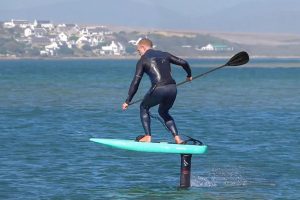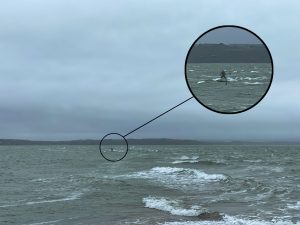21st Jan: Incident with Foil Pumpers
On watch at NCI Stone Point on a windy day just before Christmas we were observing someone who appeared to be efoiling. However when he landed on the beach we were surprised to see that the board did not have an electric motor attached to the foil. The guy must have been using his paddle to get the board foiling on the waves.
I was surprised that was possible but I searched on the web and discovered the sport was called “foil pumping”. As an example, this Youtube video explains the method. The rider angles the board upwards by pressing on the back foot, and then decreases their effective body weight by bending at the knees. For a moment or two this reduces the weight on the board allowing it to rise higher above the water. As the riders weight comes back down, the front foot is used to angle the board downwards. This causes the board to accelerate downwards and forwards.
Before the board hits the water surface the rider angles the board back upwards and again reduces their weight on the board, thus repeating the pumping action. I adapted the image from the Youtube video for a post on the NCI Blog . For a good explanation of the physics of how hydrofoils work I found this video.
In the Calshot Weekly Bulletin for 20th January I introduced the new Sail Rig Recognition diagrams which I had produced for NCI Stone Point. I had included “foil pumping” on them and that proved very timely!
As usual, on opening NCI Stone Point on Sunday 21st January I signed on with the Coastguard Joint Rescue Coordination Centre (JRCC). The Coastguard said that they had just received a 999 call from a member of the public about a “paddle boarder off Needs Oar Point heading fast towards Cowes”. With force 6 to 7 winds in the Solent and storm Isha approaching the Coastguard were concerned for the paddle boarder’s safety.
Initially we had not seen anything but with binoculars we first managed to spot a lone foil pumper approaching Lepe, and then identified another not far behind. The watchkeeper with me went down to the car park and was told that they had set off together from Lymington having earlier left their red van at Lepe. We were able to reassure the Coastguard that, as far as we could see, these were the only “paddle boarders” on the water and that they were safely ashore.
Although no one was actually in distress, had we not identified the subjects of the 999 call it is likely that a lifeboat would have been tasked. By the time it reached the Needs Oar Point area the foil surfers would have already been ashore. The lifeboat would have been out searching for people who were already returning to Lymington by road unaware that they were the subject of a SAR incident. NCI stations can, and often do, contribute to the SAR community by identifying when people are not in peril!
To our surprise, later that morning a third foil pumper appeared. Separate from the previous pair, he had set off from Hurst and also had left a van at Lepe to return by road. Talking to him I mentioned the earlier incident. He said he was also concerned that he might alarm people seeing him off shore. I told him about “RYA Safetrx” and gave him some safety literature.
All three foil pumpers were dressed in black wet suits and, with no sail, wing, or kite, they were very hard to spot in the rough water particularly when sometimes sitting astride their board to rest (see my mock-up!). Foil pumping is a relatively new sport, and the sight of “paddle boarders” at a significant distance off shore in very rough weather may well cause concern amongst members of the public. I suspect we might get further “incidents” in future!


